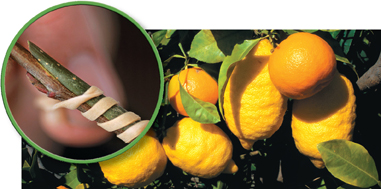
FIGURE 24–8 Grafting When just starting to bud, a branch from a lemon tree is grafted onto the branch of an established orange tree. Months later, the mature branch bears lemon fruit. Grafting leads to a single plant bearing more than one species of fruit.
Plant Propagation Horticulturists often take advantage of vegetative reproduction. To propagate plants with desirable characteristics, horticulturists use cuttings or grafting to make many identical copies of a plant or to produce offspring from seedless plants.
One of the simplest ways to reproduce plants vegetatively is by cuttings. A grower cuts from the plant a length of stem that includes a number of buds containing meristem tissue. That stem is then partially buried in soil or in a special mixture of nutrients that encourages root formation.
Grafting is a method of propagation used to reproduce seedless plants and varieties of woody plants that cannot be propagated from cuttings. To graft, a piece of stem or a lateral bud is cut from the parent plant and attached to another plant, as shown in Figure 24–8. Grafting works only when the two plants are closely related, such as when a bud from a lemon tree is grafted onto an orange tree. Grafting usually works best when plants are dormant, which allows the wounds created by the cut to heal before new growth starts.
MYSTERY CLUE

Whether the lemons grew on a grafted branch or not did not affect the ripening schedule. Rather, a certain variable that changed after the lemons were harvested contributed to the failure of the lemons to ripen. What might it have been?
24.1 Assessment

-
Review Name and describe four kinds of specialized leaves that make up a flower.
Classify Which of the structures of a flower are the male sexual organs? Which are the female organs?
-
Review Describe the features of fertilization that are characteristic of angiosperms.
Explain How is fertilization in angiosperms different from fertilization in other types of plants?
Apply Concepts Relate the characteristics of angiosperm reproduction to angiosperm success.
-
Review Define vegetative reproduction.
Compare and Contrast Compare the advantages and disadvantages of sexual reproduction versus asexual reproduction in flowering plants.
VISUAL THINKING
Review the life cycle of the green alga Chlamydomonas in Lesson 22.2. Make a compare/contrast table comparing alternation of generations in flowering plants and in Chlamydomonas. Include which stage (haploid or diploid) of each organism's life cycle is dominant and when meiosis occurs.

Table of Contents
- Formulas and Equations
- Applying Formulas and Equations
- Mean, Median, and Mode
- Estimation
- Using Measurements in Calculations
- Effects of Measurement Errors
- Accuracy
- Precision
- Comparing Accuracy and Precision
- Significant Figures
- Calculating With Significant Figures
- Scientific Notation
- Calculating With Scientific Notation
- Dimensional Analysis
- Applying Dimensional Analysis




